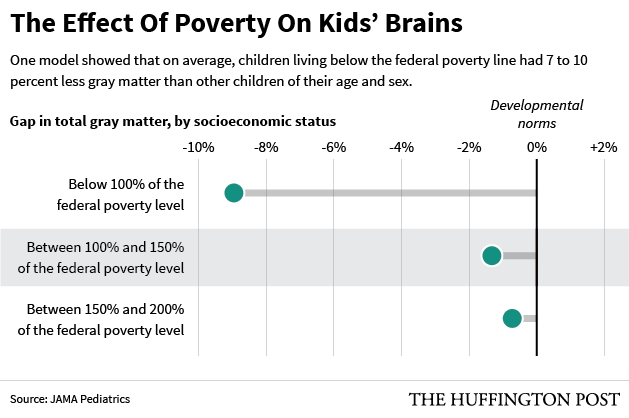
Dave Thompson/PA Wire
When U.S. scientists confirmed that lead exposure from gasoline caused permanent mental disability, deafness and a host of other health problems, the Environmental Protection Agency acted swiftly in 1973, calling for the incremental reduction of lead in fuel.
Child development researcher Seth Pollak of the University of Wisconsin–Madison hopes that people will come to feel the same way about poverty's affects on children’s brain development. "There was a toxin in the environment that was actually altering children’s developmental biology,” he said. "I think now poverty is looking like that."
Pollak’s most recent study, published July 20 in the prestigious JAMA Pediatrics medical journal, adds the missing piece to a puzzle scientists have long considered: Do poor children score lower on tests because of brain changes caused by the deprivations of poverty? Past research has shown that poor children have smaller brains than children who grew up in more comfortable circumstances. And other research shows poor children also tend to score lower on standardized tests than richer children. But Pollak’s statistical analysis of MRI scans from 389 children and teens over six years confirms a new relationship: Poor kids’ smaller brains are linked to their test score deficit when compared to middle class and rich kids.
"Now we actually know through this study that it is the delay of brain growth that is accounting for the lower test scores in school,” he said.
Pollak and his team analyzed 839 MRI scans from 301 economically diverse children across the U.S. The scans, collected from 2001 to 2007, were taken approximately every two years for each child, for a total of three check-ins. Drawn from six different places in the U.S., the kids were representative of U.S. demographic factors like income, race and ethnicity, and one-quarter of the children were from homes that lived below 200 percent of the federal poverty level at that time (in 2007, 200 percent of the FPL was $41,300 for a family of four).
The researchers made sure to exclude subjects who were born from risky pregnancies or complicated births, children from families with histories of mental illness and children who were already exhibiting behavioral or psychiatric issues, including low IQ. He also controlled for head size at birth. In other words, these children started life in similarly healthy states.
The MRI scans confirmed that as poor children grew, the areas of the brain that were most susceptible to environmental influence and crucial for academic development had structural differences from middle-class and rich kids. The poor kids also had less gray matter overall than the other children, with the deficits getting worse for the kids who lived below the federal poverty line.

Huffington Post
Using math models to plot the differences, Pollak found that these deficits in the brains of poor kids explained as much as 15 to 20 percent of their poor test achievement.
"This study is not about just having smaller brains,” Pollak explained. “Those delays in brain growth are actually statistically explaining the achievement test score differences.”
Greg Duncan, an economist at the University of California, Irvine and author of the book Restoring Opportunity: The Crisis of Inequality and the Challenge for American Education, called Pollak’s findings “very scary” but not surprising.
“There is ongoing debate all the time in Congress about whether or not to cut benefit levels in programs like food stamps and the earned income tax credit, and that debate usually centers around whether the parents are lazy or not,” said Duncan. “What studies like this suggest is that cutting benefit levels in programs that support low income families may have consequences for kids’ brain development. That makes it very scary indeed."
Duncan wasn’t involved in Pollak’s study, but praised it as “strong” correlational research for its large sample size over a long period of time, as well as Pollak’s efforts to control for variables like birth weight and a mother’s education. However, he pointed out, only experimental research can establish cause and effect — that is, whether a higher parental income results in bigger brains for children.
Pollak was surprised by one aspect of his research. He expected the wealth-brain size relationship to increase exponentially, with the wealthiest kids having the biggest brains and highest achievement and the poorest kids with the smallest brains and lowest achievement. Instead, he said, there were “absolutely no differences” between middle class kids and affluent kids when it came to brain size or test scores, suggesting that instead of an upward curve, the line looked more like a step, with poor kids near the bottom and everyone else on a higher level.
“That suggests to me that this isn’t just a function of how much stuff you’ve got,” said Pollak. “Something is happening to children who are living in severe poverty, and that’s where the brain growth appears to be affected."
For Pollak, this correlational research is strong enough for him to discuss its implications in talks and presentations — and people are listening. He notes that his discussion of poverty as a biomedical problem, not a social problem, seems to unite people on opposite ends of the ideological spectrum on solutions to shield kids from its effects. He hopes that his latest research continues to do the same for politicians and thought leaders.
“Maybe this helps policymakers and people in communities band together to think about what needs to be done here,” Pollak concluded.
CORRECTION: A previous version of this story misspelled Seth Pollak's name. We regret the error.
Also on HuffPost:
